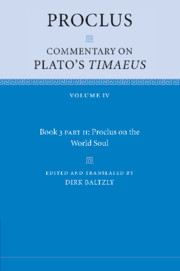Introduction to Book 3, Part II
Published online by Cambridge University Press: 30 June 2022
Summary
THE BACKGROUND TO PROCLUS’ COMMENTARY ON THE WORLD SOUL IN TIMAEUS
Proclus’ treatment of the composition of the World Soul and the harmonic ratios within it is the most in-depth portion of the surviving commentary. Proclus expends 216 pages of text on the 86 OCT lines from Timaeus 34b2–37c5. This yields a page-to-line ratio that slightly outstrips the effort that Proclus expends on the Demiurge and his model (Tim. 27c1–31b3) in Book II of the Timaeus commentary. (To be precise: 2.51 pages/line versus 2.39 pages/line.) The interest of the latter passage to a Platonist is obvious; we are talking about nothing less than the identity of the Demiurge and the nature of the Intelligible Paradigm to which he looks in creating the visible cosmos. It is true that Proclus must also contend with what he takes to be seriously mistaken views of this part of Plato's text, viz. those previous interpreters who suppose that Plato describes here a creation of the cosmos in time. Hence a great deal of time and effort go into refuting the views of previous interpreters, such as Plutarch and Atticus.
Naturally, the subject of the World Soul is equally interesting to a Platonist. However, I think that Proclus’ level of effort on the World Soul is largely determined by the difficulties of detail in Plato's text that had already generated a considerable literature. Proclus engages at length with these alternative interpretations and in the course of doing so tells us a great deal about such figures as Severus and Theodore of Asine. Indeed, the longest and most detailed testimonia that we possess about the latter come from just this portion of Proclus’ commentary. Thus in order to put Proclus’ work into some sort of context, we need to consider it against the backdrop of the history of interpretations of Timaeus 34b–37c. The following remarks will add little to the work of Baltes and Brisson, but they will perhaps be sufficient for shedding some light on Proclus’ relation to the previous tradition.
- Type
- Chapter
- Information
- Proclus: Commentary on Plato’s Timaeus Volume 4: Book 3, Part 2: Proclus on the World Soul , pp. 1 - 50Publisher: Cambridge University PressPrint publication year: 2009



